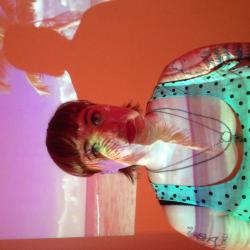When Amanda Riffo got word that the 2024 Icelandic Art Prize had been bestowed on her, flight was her first instinct.
“I felt super shy,” she says, laughing with a warmth that exudes through our video call. “I was like, ‘what if I just don’t do it and just escape,’”
Luckily the Reykjavík-based French-Chilean artist did not bolt into the night and instead bravely received the honour for her exhibition House of Purkinje, which showed at the Living Art Museum in Spring 2023. The exhibition weaved ongoing themes of the internationally established artist’s more than 20 year long career, highlighted with a self-satirising twist of an artist running out of time.
“I did put a lot into this exhibition under special conditions that I had to use all the shortcuts possible,” she details having to juggle the short turnaround for creating the exhibition conflicting with her work in the film industry, in which she’s also well established. “It’s more like a 200% job, not 50/50.”
Luckily for the potential financial woes of career clashes, House of Purkinje – curated by Sunna Ástþórsdóttir – was fully funded by the Icelandic Visual Arts Fund, the same organisation who granted Amanda the Icelandic Art Prize.
The prize was established by the Icelandic Visual Arts Council in 2018 and was awarded this year on March 14. Amanda’s victory marks the first time a person of foreign origin based in Iceland wins the prize exclusively for a solo exhibition. However the accolade has less nationalistic significance for Amanda than one could presume.
“I’m not used to winning prizes at all, so there’s two levels for me,” she explains. “First there is getting this prize in Iceland and the other is getting a prize for an exhibition I did. Of course, it’s very special because I live here but I’m not from Iceland. Also to have this recognition for my art rather than something else is very important for me.”
Amanda’s duality of feelings around the prize reflect similarly to her “way of thinking” that runs through all her art, a particular intrinsic outlook stemming from her own ophthalmological experiences that inform her literal worldview.
“It’s close to exploiting all kinds of misunderstandings. For example, I notice something and I misunderstand it and this misunderstanding will still be kept in my memory even if it’s remedied. I like to experiment with what I see basically because my eyesight is terrible. It’s a bit like psychedelia without psychotropics.”
These visual misunderstandings — she tosses out a whimsical example of mistaking a flock of sheep on the horizon for a giant white cat — along with a fascination for the eye as an organ and a metaphor, have become a through line of her unique practice and output.
“It’s maybe cliché to say, but it’s a bit like the window you have to the exterior, like the most obvious sense of understanding what’s around you. It’s a very funny organ, because the way it works is complex, but at the same time so basic and magical.”
Somehow the pairing of the last two adjectives seems like an apt description of Amanda herself. A truly genuine person with an earthy demeanour whose inner world and thought process are enchantingly variegated. It’s perhaps these qualities that do not make her haughty about the award.
“When you’ve been doing art all your life, and you do an exhibition and you get rewarded for that… To get a national art prize for this exhibition meant a lot for me, forgetting that we are in Iceland. But there are other experiences that would have made me feel validated in this career.”
Amanda’s future plans currently include an experimental “lab” exhibition with artists Nermine El Ansari and Deepa Iyengar this summer at Ásmundarsalur, followed by an art research residency in Tokyo for several months. Neither of these stretch further ahead than the end of the current year.
“I cannot see too far – literally,” we both burst out laughing. “I’m short-sighted, but not short in vision!”
Buy subscriptions, t-shirts and more from our shop right here!


















